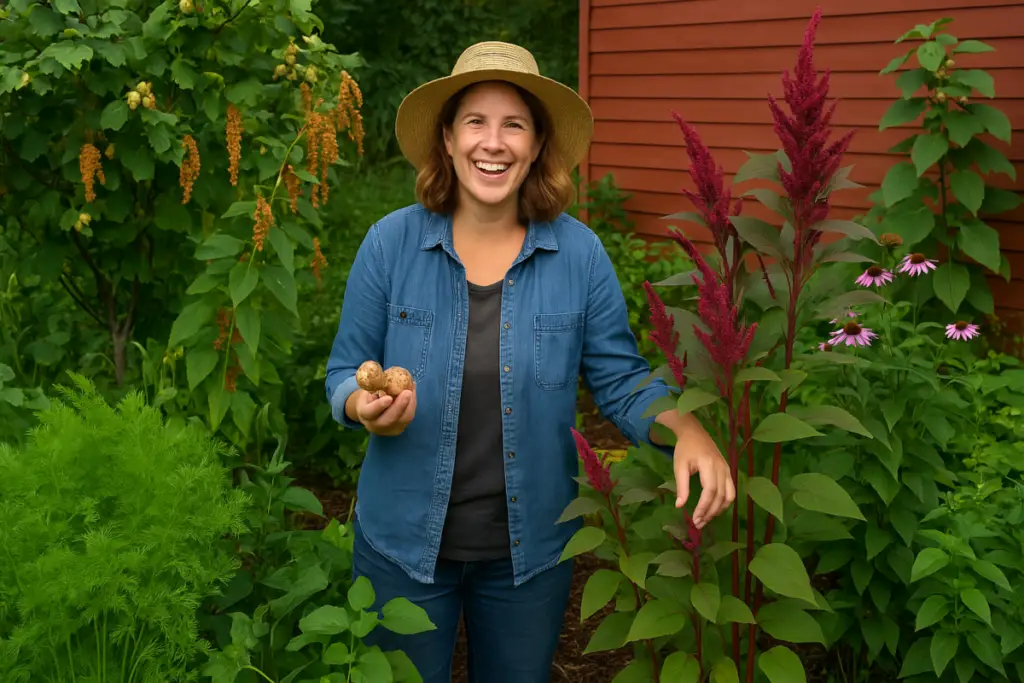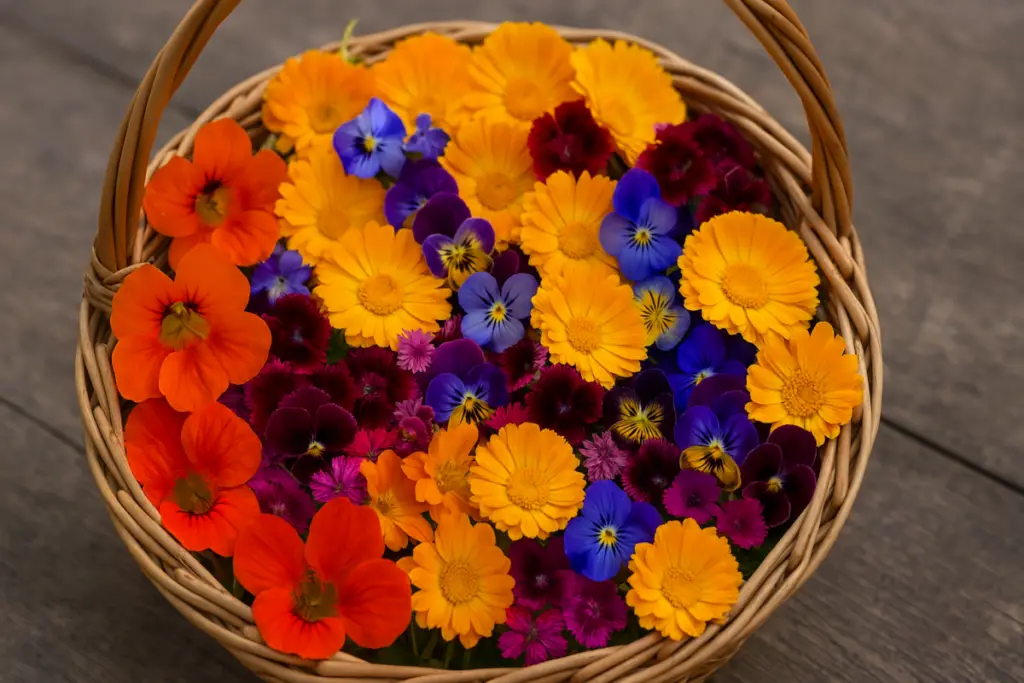
Ever thought your backyard garden was limited to tomatoes, lettuce, and maybe some herbs? Think again! Imagine stepping outside and harvesting your own almonds, quinoa, or calming herbs like chamomile and ashwagandha—all from a modest plot of land right behind your house. Sounds far-fetched? Not anymore.
As more folks look for ways to boost self-reliance, cut grocery costs, and live closer to nature, a quiet revolution is taking root—right in the soil of unconventional backyard gardens. Gardeners everywhere are rediscovering the joy and satisfaction of growing crops that are a little out of the ordinary but pack a big punch in flavor, nutrition, and sustainability.
From ancient grains to medicinal herbs and edible flowers, these crops aren’t just beautiful—they’re practical, powerful, and surprisingly easy to grow. And best of all, they open the door to a more diverse, resilient, and rewarding way to garden.
If you’re craving something more than the usual lettuce patch—or you just want to get more from your space—you’re in for a treat. Let’s explore some of the most rewarding and unique crops you can grow right at home. Your backyard is more capable than you think!
Why Go Beyond Traditional Garden Crops?
Benefits of Diverse Gardening
Adding unusual plants to your garden isn’t just fun—it’s smart. You’re increasing food security, enhancing biodiversity, and supporting sustainable gardening practices. Plus, it’s a great way to introduce new flavors and nutrition into your diet! Diverse gardens attract beneficial insects and improve pollination rates. This helps strengthen overall ecosystem health and resilience. They also reduce the need for chemical fertilizers and pesticides, making your gardening practices more eco-friendly and sustainable.
Who Should Try It?
- Gardeners looking to boost their garden’s sustainability and ecological impact.
- Urban folks interested in edible landscaping and permaculture methods.
- Families wanting educational activities that encourage outdoor engagement.
- Health-conscious individuals interested in organic and nutrient-rich foods.
- Anyone who loves experimenting with new, nutritious, and delicious foods.
Nut Trees for Small Spaces
Compact Nut Trees Suitable for Urban Gardens
- Hazelnuts: Easy, small, and abundant yield. Ideal for small gardens or even large containers!
- Almonds: Perfect for warmer climates; highly drought-resistant and provide beautiful blossoms each spring.
- Chestnuts: Smaller dwarf varieties available; highly nutritious nuts with multiple culinary uses.
Tips for Nut Tree Cultivation
Integrate nut trees with other plants, such as shade-loving vegetables, herbs, or mushrooms, to maximize space and productivity. Proper spacing and occasional pruning ensure healthy growth. Nut trees also improve your garden’s ecosystem by attracting beneficial wildlife such as bees, butterflies, and insect-eating birds like wrens and chickadees like pollinators and birds.
Climate-Smart Backyard Grains
Ancient Grains for Climate Resilience
- Quinoa & Amaranth: Nutrient-rich and adaptable to varying climates, these grains offer protein-packed harvests.
- Millet & Sorghum: Easy-to-grow grains that withstand drought, heat, and challenging conditions.
- Teff: An ancient grain gaining popularity for its versatility and nutritional density.
Planting and Harvesting Guide
Plant grains directly in your garden bed—no need for expensive gear! Just scatter the seeds, gently cover them with soil, and water consistently. Harvesting is simple too. Threshing and winnowing can be done by hand or with basic household tools, like a colander for sifting, a box fan for separating chaff, or even a pillowcase to help shake seeds loose. These methods make grain growing accessible for any home gardener.
Trending Medicinal Herbs for Wellness Gardens
Herbs for Health and Wellness
- Ashwagandha: Amazing adaptogen herb for stress reduction and mental clarity.
- Tulsi & Gotu Kola: Enhance cognitive function, reduce anxiety, and boost general vitality.
- Echinacea & Mullein: Support robust immunity and respiratory health, essential for seasonal wellness.
- Chamomile & Lemon Balm: Gentle calming herbs perfect for homemade teas to relieve stress and improve sleep.
Integration Tips
Use companion planting to support crop health, deter pests, and maximize space efficiency. DIY herbal teas, tinctures, and remedies from your garden are incredibly rewarding and offer genuine health benefits.
Low-Maintenance Climate-Resilient Perennials
Effortless Sustainability
- Jerusalem Artichokes & Rhubarb: Hardy, tasty, and come back every year without fuss.
- Perennial Kale & Egyptian Walking Onions: Minimal care required with consistent yields and impressive resilience.
- Sea Kale: Beautiful foliage and edible leaves, tolerates salty air and poor soils.
Benefits of Perennials
Imagine planting once and harvesting forever! Perennial crops are low-maintenance and highly productive, creating a reliable “perennial pantry” that saves time, effort, and money.
Edible Flowers and Therapeutic Gardening
Flowers with Purpose
- Nasturtium & Calendula: Gorgeous, edible, and medicinal, enhancing both salads and skincare.
- Lavender & Hibiscus: Delicious additions to culinary recipes, soothing in teas, and attractors of essential pollinators.
- Borage & Violas: Pretty blooms that taste delightful in salads or garnishes, promoting garden biodiversity.
Utilization and Preservation
Create flavorful edible flower salads, relaxing therapeutic teas, or natural beauty and skincare products right from your backyard harvest.

Innovative Tips for Unusual Crop Gardening
Advanced Gardening Techniques
- Guild Planting: Pair plants that support each other naturally through nutrient sharing, pest deterrence, and enhanced growth.
- Vertical Gardening & Smart Systems: Maximize your space with modern gardening apps, automatic smart watering, and innovative vertical planting solutions.
Soil and Space Management
Healthy soil is fundamental—prepare your beds with compost and organic matter. Creative planting solutions such as intercropping, raised beds, and vertical gardening ensure optimal productivity and efficient space use.
| Gardening Method | Benefits | Best for |
| Vertical Gardening | Saves space, maximizes sunlight | Small, urban gardens |
| Guild Planting | Natural pest control, soil health | Sustainable gardeners |
| Smart Gardening | Easy management, efficient water use | Busy, tech-savvy gardeners |
Diverse Real-Life Success Stories
- Urban Balcony Success: Thriving almonds and quinoa harvested from balcony containers.
- Suburban Wellness Gardens: Families integrating herbs daily for improved health and wellness routines.
- Community Gardens: Communities strengthening bonds and nutrition by cultivating educational, edible landscapes.
Final Thoughts: Embrace Garden Diversity
Gardening is more than just a hobby—it’s a living, breathing connection to the earth, our food, and each other. When we branch out from the typical backyard staples and grow something a little out of the ordinary, we’re not just adding variety to our meals—we’re building resilience, community, and a deeper appreciation for nature’s potential.
Unusual crops like ancient grains, medicinal herbs, and compact nut trees don’t just stand out—they nourish us in unique and meaningful ways. They encourage us to learn, adapt, and explore what’s possible in our own backyard, no matter the size.
And perhaps best of all, they create stories worth sharing—like the moment your first homegrown quinoa came to harvest, or when your chamomile made the perfect bedtime tea.
So why not take that leap? Whether it’s planting a new variety you’ve never tried, experimenting with edible flowers, or starting your own mini food forest, the joy is in the journey.
Share your experiments, wins, and learning moments with fellow gardeners—we’re all growing together!
FAQ: Growing Unusual Crops in Your Backyard
1. Are these unusual crops hard to grow for beginners?
Not necessarily! Many unusual crops are surprisingly resilient and low-maintenance. Nasturtium, Jerusalem artichokes, and amaranth are excellent starter choices because they tolerate less-than-perfect soil and weather conditions. The key is to start small and experiment—watch how each plant responds to your space and climate. You’ll learn a lot in your first season just by observing, adjusting, and noting what works well.
2. Can I grow grains in a small backyard or even on a balcony?
Yes, you can—and it’s incredibly rewarding. Compact grains like quinoa, amaranth, and millet do well in containers or tightly spaced raised beds. While you may not feed a family of four from a balcony harvest, these grains teach you the process of self-reliant food growing. They also add a unique visual flair to your garden. With the right care—good sun exposure, consistent watering, and occasional thinning—your small space can yield impressive results.
3. What’s the best way to get started with medicinal herbs?
Start with 3–5 versatile, well-documented herbs like chamomile, lemon balm, echinacea, or tulsi. These not only serve a wide range of wellness needs but also grow well in most climates and soil types. Consider how you’ll use them—teas, salves, tinctures—and plant accordingly. Be mindful of harvesting timing, which can influence potency. Over time, building your own herbal apothecary can become a practical and deeply satisfying part of your garden routine.
4. How do I harvest and use edible flowers safely?
First, make absolutely sure the flower is edible and pesticide-free. Stick to well-known varieties like calendula, nasturtium, lavender, and violas. Harvest flowers in the cool morning hours when their flavors are most vibrant. Use them in salads, teas, syrups, or even ice cubes for drinks. Remember, petals are usually the safest parts to eat, and moderation is key since some flowers are more medicinal than culinary. Drying and preserving petals can extend their usefulness for homemade beauty or wellness projects.
5. Where can I find seeds or starter plants for these crops?
There are more resources now than ever before. Look to local nurseries, seed libraries, farmers markets, and regional seed exchanges—they often carry varieties suited to your microclimate. Online, reliable options include True Leaf Market, Strictly Medicinal Seeds, and Baker Creek Heirloom Seeds. Many sites offer growing guides and customer reviews, which are great for figuring out what will thrive in your space. You can also join online gardening communities to swap seeds and learn from others growing the same crops.

